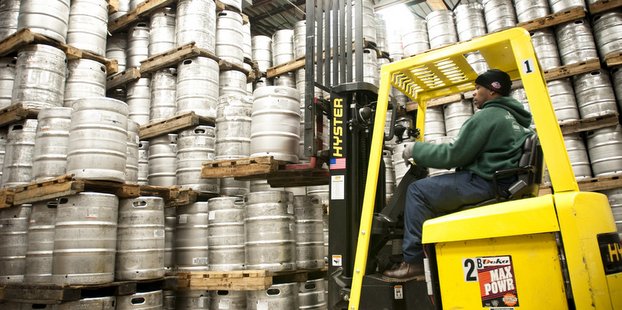
Musculoskeletal injuries (MSDs) cost U.S. businesses $31 billion a year in direct costs alone, and according to the U.S. Bureau of Labor Statistics, stock and material movers incur more MSDs than any other occupation. Craft breweries aren’t immune to this issue: A case of bottled beer can weigh up to 42 pounds, an empty keg weighs 30 pounds, and a full keg weighs a whopping 160 pounds. Moving that amount of weight each day, coupled with the constant lifting, pushing and pulling of heavy machinery can lead to significant risk of developing a musculoskeletal injury.
Training your workforce to prevent common MSDs like back injuries, strains and sprains will not only help you reduce injury costs, but it typically has a positive impact on culture and productivity. To help protect the professionals that manufacture and transport your beer every day, try these five proven tips in your work environment:
Keep in mind that movement matters in every environment
Safety efforts today are largely centered around engineering the environment to protect people from injury. What is too often overlooked is how the very same individuals we are trying to protect move through that environment.
We’ve found that injuries sustained while moving something as small as an individual beer bottle are as common as those sustained while moving a heavy keg when the employee lacks the proper training. By educating individuals on how to lift, carry, push, pull, step up or down, we can empower them to stay in the strongest, safest possible positions regardless of the situation or environment.
Keep your spine neutral
Back pain is one of the most common reasons people go to the doctor or miss work, and it’s a leading cause of disability worldwide. You may be the strongest guy in the gym, but when it’s time to lift a 50-pound case of beer off the ground for the 100th time today, poor form will make the task difficult and painful.
As you bend over to lift and load kegs or to clean a piece of equipment, you can significantly reduce the risk of back injury by focusing on keeping your entire spine aligned and in a neutral position through the neck.
Watch your descent
Whether you’re working on a ladder, forklift, or a truck cab you’ll have to ascend and descend at some point, and often frequently. When climbing up or down any elevation that is high enough to require a step, you should always turn backwards to face the equipment and control your descent. Climbing down backwards enables you to use your hands in the safest, strongest position for your shoulders. You will also be able to engage the strongest muscles in your legs as you control your body weight and climb down.
Point your thumbs out
When reaching to grab product or clean equipment, the shoulder can be forced into a weak position. When the shoulder rotates forward, it adds unwanted stress to the rotator cuff and upper back, increasing your injury risk.
A quick way to help straighten out your shoulder and upper back is to stand up with your arms at your sides and turn your thumbs away from your body (think of that poster of the anatomical man in your doctor’s office). See if you can feel your shoulders shift back and down into a strong neutral position. Once reset, you can let your hand position relax and try not to lose that neutral upper back.
Stand tall, chin in
The head and neck are integral parts of the spinal chain. For every inch that your head moves forward past your shoulders, 10 pounds of pressure is added to the muscles in your neck. Over time, this force can significantly damage the spine, and permanently alter your posture. Protect your neck by making sure your chin is tucked as you move, and that your head is stacked over your shoulders and aligning your spine in a neutral position.
Although the most common workplace injuries result from simple, repetitive movements that frontline workers do every day, the good news is that keeping them safe and healthy can be achieved by reinforcing techniques like the above through continuous micro-learning and in-person practice. When applied consistently, these techniques will help your employees decrease their risk of injury and go home pain-free at the end of the day.
John Leo Post is the co-founder and vice president of product for Worklete, a technology platform that reduces musculoskeletal injuries by 53 percent on average.






Leave a Reply
You must be logged in to post a comment.